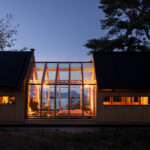St. Andrews Girl’s hostel – The Girls’ Hostel Block in Gurugram explores the intersection of education and sustainability through the lens of the vernacular. The hostel is home to approximately 130 students, with dorm rooms spread across four levels in addition to hosting ancillary spaces like a pantry, recreational areas as well as social spaces. The design takes cues from the rural context of the site and unfolds as a series of multidimensional spaces, through the method of adaptive layering. A unique double-skin facade reduces incident direct and diffused radiations on the principal facade by 70%, thus, minimizing heat gain within the habitable spaces behind the block wall. The hostel’s design empowers students with freedom of movement within an environment that prioritizes thermal comfort and functionality to become an exemplar of zero energy design.
Architizer chatted with Ar. Sachin Rastogi, Principal Architect at ZED Lab to learn more about this project.
Architizer: What inspired the initial concept for your design?
Ar. Sachin Rastogi: Home to approximately 130 students, with dorm rooms spread across four levels the hostel also includes ancillary spaces like a pantry, recreational areas as well as social spaces. The primary design challenge was to create a secure hub for the girls — a campus within a campus that did not restrict movement, while establishing a connection with the outdoors. A typical hostel block would consist of a defined indoor, outdoor and recreation area like a canteen or a mess. To break free from such conventional zoning, multi layered functions and spaces were created . The design seeks to reinterpret conventional standards of human comfort through introducing the idea of adaptive comfort — the principle that people experience differently and adapt, up to a certain extent, to a variety of indoor conditions, depending on their clothing, their activity and general physical condition.

© ZED Lab

© ZED Lab
What do you believe is the most unique or ‘standout’ component of the project?
The unique nature of the building is revealed as soon as one enters the buffer/ common space, which is the communal heart of the building. This space often referred to as the ‘third space’ by the designers, holds a prominent staircase as the centerpiece, which is an alternate translation of a typical fire escape. The space is an organized collage of balconies, terraces, bridges, staircases, seating areas, landscaping and roof + façade apertures. This gives the space its characteristics of the hostel’s social nucleus with a large variety of spaces with varying levels of privacy for both group and individual occupation.

© ZED Lab
What was the greatest design challenge you faced during the project, and how did you navigate it?
The design faced a series of challenges from conception to execution. The primary design challenge was to create a secure hub for the girls — a campus within a campus fitting into the urban master plan that did not restrict the movement while establishing a connection with the outdoors.
The other challenge that was faced during the construction was that the labour was not skilled enough to do dry construction on site. The labour was exposed to this technique of rotating blocks on a 20’ high free standing facade with no use of mortar adding it to their skill set. Building this structure with the most basic construction material ‘brick’ had an impact on the neighborhood where the common man is the architect himself. It broadened their perspective and taught them avenues of construction of their own buildings.

© ZED Lab
What drove the selection of materials used in the project?
In a harsh climate like Gurugram, there was a need felt to create a third space between the inside and the outside. Hence the requirement of an innovative material arose whose challenge was met by a customized hollow concrete block of 8”x8”x8”(lxhxd). It was pre-fabricated to reduce the wastage on site and pigmented to resemble the color of red brick. It is a self load bearing block which requires no reinforcement in a 20 feet high free standing facade, saving on cost and labor. The blocks have been successful in addressing three concerns. Not only do they provide adequate thermal mass to absorb the heat, but with a depth of eight inches, the direct radiation has to penetrate through several layers reducing glare in the interiors. In addition, since the block is penetrable, the air volume passing through this mass loses its heat through compression.

© ZED Lab
How important was sustainability as a design criteria as you worked on this project?
The building perimeter is blanketed with a transition space, creating a mean outdoor climate by regulating airflow & decreasing direct and diffused radiations by 70% on the primary double skin facade of customized hollow pre-fabricated concrete block of 8”x8”x8”(lxhxd), reducing the wastage on site and pigmented, resembling the color of red brick & required no reinforcement in a 20′ high free-standing facade, saving on cost & labor. Having thermal mass to absorb the heat, the direct radiation has to penetrate through several layers within the block, getting reflected on different surfaces multiple times before entering the interiors, reducing glare and are also slightly rotated at a specific angle based on the insulation analysis with respect to solar heat gain. The air volume passing through the penetrable blocks loses its heat through compression on the basis of Bernoulli’s principle.

© ZED Lab

© ZED Lab


















 St. Andrews Girl's hostel
St. Andrews Girl's hostel 


